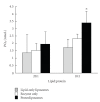Lipid bilayer composition affects transmembrane protein orientation and function
- PMID: 21490797
- PMCID: PMC3068514
- DOI: 10.1155/2011/208457
Lipid bilayer composition affects transmembrane protein orientation and function
Abstract
Sperm membranes change in structure and composition upon ejaculation to undergo capacitation, a molecular transformation which enables spermatozoa to undergo the acrosome reaction and be capable of fertilization. Changes to the membrane environment including lipid composition, specifically lipid microdomains, may be responsible for enabling capacitation. To study the effect of lipid environment on proteins, liposomes were created using lipids extracted from bull sperm membranes, with or without a protein (Na(+) K(+)-ATPase or α-amylase). Protein incorporation, function, and orientation were determined. Fluorescence resonance energy transfer (FRET) confirmed protein inclusion in the lipid bilayer, and protein function was confirmed using a colourometric assay of phosphate production from ATP cleavage. In the native lipid liposomes, ATPase was oriented with the β subunit facing the outer leaflet, while changing the lipid composition to 50% native lipids and 50% exogenous lipids significantly altered this orientation of Na(+) K(+)-ATPase within the membranes.
Figures






Similar articles
-
Na,K-ATPase reconstituted in liposomes: effects of lipid composition on hydrolytic activity and enzyme orientation.Colloids Surf B Biointerfaces. 2005 Apr 10;41(4):239-48. doi: 10.1016/j.colsurfb.2004.12.013. Colloids Surf B Biointerfaces. 2005. PMID: 15748819
-
Na/K-ATPase regulates bovine sperm capacitation through raft- and non-raft-mediated signaling mechanisms.Mol Reprod Dev. 2017 Nov;84(11):1168-1182. doi: 10.1002/mrd.22879. Epub 2017 Sep 27. Mol Reprod Dev. 2017. PMID: 28833817
-
Chemical and physical requirements for lipid extraction by bovine binder of sperm BSP1.Biochim Biophys Acta. 2013 Feb;1828(2):543-51. doi: 10.1016/j.bbamem.2012.08.020. Epub 2012 Aug 30. Biochim Biophys Acta. 2013. PMID: 22960042
-
Membrane lipid dynamics during human sperm capacitation.Front Biosci. 1996 Jul 1;1:d103-17. doi: 10.2741/a119. Front Biosci. 1996. PMID: 9159218 Review.
-
Capacitation-dependent reorganization of microdomains in the apical sperm head plasma membrane: functional relationship with zona binding and the zona-induced acrosome reaction.Theriogenology. 2008 Nov;70(8):1188-96. doi: 10.1016/j.theriogenology.2008.06.021. Epub 2008 Jul 21. Theriogenology. 2008. PMID: 18640708 Review.
Cited by
-
Lipid-dependent generation of dual topology for a membrane protein.J Biol Chem. 2012 Nov 2;287(45):37939-48. doi: 10.1074/jbc.M112.404103. Epub 2012 Sep 10. J Biol Chem. 2012. PMID: 22969082 Free PMC article.
-
Two-Player Game in a Complex Landscape: 26S Proteasome, PKA, and Intracellular Calcium Concentration Modulate Mammalian Sperm Capacitation by Creating an Integrated Dialogue-A Computational Analysis.Int J Mol Sci. 2020 Aug 29;21(17):6256. doi: 10.3390/ijms21176256. Int J Mol Sci. 2020. PMID: 32872422 Free PMC article.
-
The Transporter-Mediated Cellular Uptake and Efflux of Pharmaceutical Drugs and Biotechnology Products: How and Why Phospholipid Bilayer Transport Is Negligible in Real Biomembranes.Molecules. 2021 Sep 16;26(18):5629. doi: 10.3390/molecules26185629. Molecules. 2021. PMID: 34577099 Free PMC article. Review.
-
Sphingolipids and Male Reproductive Health: A Narrative Review of Their Roles in Spermatogenesis, Fertility, and Dysfunction.Reprod Sci. 2025 Jul;32(7):2121-2136. doi: 10.1007/s43032-025-01898-4. Epub 2025 Jun 12. Reprod Sci. 2025. PMID: 40506656 Review.
-
Na/K-ATPase and Regulation of Sperm Function.Anim Reprod. 2018 Aug 3;15(Suppl 1):711-720. doi: 10.21451/1984-3143-AR2018-0024. eCollection 2018 Jul-Sep. Anim Reprod. 2018. PMID: 36249829 Free PMC article.
References
-
- Post H, Schwarz A, Brandenburger T, Aumüller G, Wilhelm B. Arrangement of PMCA4 in bovine sperm membrane fractions. International Journal of Andrology. 2010;33(6):775–783. - PubMed
-
- Edidin M. Lipids on the frontier: a century of cell-membrane bilayers. Nature Reviews Molecular Cell Biology. 2003;4(5):414–418. - PubMed
-
- Khalil MB, Chakrabandhu K, Xu H, et al. Sperm capacitation induces an increase in lipid rafts having zona pellucida binding ability and containing sulfogalactosylglycerolipid. Developmental Biology. 2006;290(1):220–235. - PubMed
-
- Yanagimachi R. Mammalian fertilization. In: Knobil E, Neill J, editors. The Physiology of Reproduction. Vol. 1. New York, NY, USA: Raven Press; 1994. pp. 189–317.
-
- Gadella BM, Tsai PS, Boerke A, Brewis IA. Sperm head membrane reorganisation during capacitation. International Journal of Developmental Biology. 2008;52(5-6):473–480. - PubMed
LinkOut - more resources
Full Text Sources

